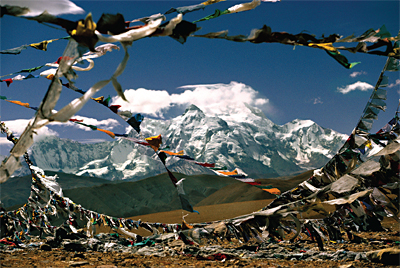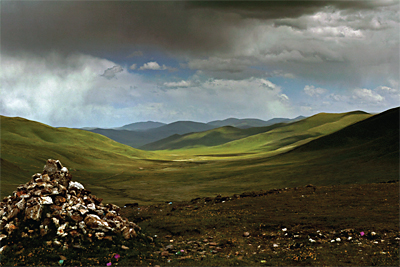Before you were a monk, you were a scientist in cell genetics. How does science inform your perspective on meditation?
The basis of science is a rigorous, empirical, and pragmatic approach to everything. A suitable theory has to include the possibility that it can be proven or disproved by fact. A theory that has a ready-made explanation for anything that could happen (like the theory of universal selfishness or psychoanalysis, to give just two examples) is not scientific. A theory should not be just an intellectual construct, but it has to be in tune with reality.
One of the main pursuits of Buddhism is to bridge the gap between the way things appear and the way things are. That approach does not come just from a curiosity to investigate phenomena. It arises from the understanding that an incorrect perception of reality inevitably leads to suffering. Grasping to solid reality and to the notion of an independent self in particular engenders a host of afflictive mental states and afflictive emotions that are the primary cause of mind-made sufferings.
Thus Buddhist science is not just an intellectual pursuit for the sake of unraveling the mystery of nature, but it also has a therapeutic aspect that gets to the very basic cause of suffering. In this context, a rigorous pursuit of science is not to hold a blind belief in anything but to honestly and eagerly pursue the investigation of the mechanism of happiness and suffering.
Are there things that science can’t measure?
Science is an authentic, valid means of knowledge. Science is not only about what you can measure; it is also about investigating the relative and ultimate nature of things. A valid means of investigation can be applied to the nature of mind. Provided these means are logical, rigorous, and can be tested experimentally, they do not absolutely require physical measurements. If, for instance, you evaluate the consequences of destructive emotions on your state of mind, you can investigate this thoroughly and repeatedly over time and draw conclusions about the states of mind that need to be phased out and those that need to be cultivated, without necessarily having to “measure” anything physical.

If scientists could manipulate brain chemistry to make somebody happier, would this be beneficial?
Well, the problem with all that is the definition of happiness. I think there is a lack of clarity about what we mean by genuine happiness. People are often eager to generate pleasant feelings. Thinking that happiness is just an endless succession of pleasant experiences seems more like a recipe for exhaustion than it is for happiness. Happiness is a way of being, not a sensation. If you are only looking for pleasure, then you need to know that there’s probably no way that the brain could sustain pleasurable sensations forever.
By activating some areas of the brain, you could possibly generate a sensation of intense pleasure for a while, but that’s not going to last forever. That’s definitely not happiness. It is just a temporary gimmick. Genuine happiness is a state related to wisdom, to being attuned to reality, and to freedom from mental toxins (hatred, craving, and the like). Pleasure by itself has no reason to engender freedom from ignorance, dualistic clinging, and distortion of reality (true causes of suffering). There is nothing wrong with pleasure in itself, but it does not have much to do with happiness.
Recently you’ve been involved with the Mind & Life institute—which studies the relationship between Buddhist science and contemporary sciences. Could you tell us a little bit about the work you’ve done there?
I knew Francisco Varela, the cofounder of the Mind & Life Institute, for 30 years or so. He came to visit my teacher Dilgo Khyentse Rinpoche, in France and in Nepal. Although I was close to him as a friend, I didn’t know much about Mind & Life at that time. Then in 2000 he asked me to participate in the Institute’s conference about destructive emotions with His Holiness the Dalai Lama. That was really a wonderful meeting. Many great scientific luminaries were there, such as Paul Ekman and Richard Davidson. It was then that the idea of doing more serious research was broached. When His Holiness asked: “What can we contribute to society?” the scientists told him, “If we do serious research about meditation, that could be a wonderful contribution.”
If people took mind training and meditation more seriously, it would be a good service to humanity. People would start to care for a healthy mind as much as they try to care to have a healthy body. Since I was an “apprentice” scientist even though I had not been very active in that field for 30 years, I volunteered to participate. I went to Francisco’s lab in Paris and later to Richard Davidson’s lab in Madison and Paul Ekman’s lab in San Francisco. Together we tried to devise suitable experimental protocols to study meditation. For that we needed to consider for instance, how long does it takes to get into a meditative state? How long do you need to sustain it to see some detectable effect?
All these factors have to be examined with the practitioners themselves. I offered myself as a guinea pig, and after seeing that the first results were very encouraging I asked several experienced meditators, monks, and lay practitioners—men and women—in the East and in the West to participate. They became the first group of long-term meditators who had practiced between 20 and 50,000 hours of meditation.
The Mind & Life Institute has spearheaded groundbreaking research, especially in the new field of contemplative neurosciences and psychology. It is now becoming active in Europe too, for instance at the lab of Tania Singer, who is working on empathy and compassion. All this research and the results published in scientific journals show that we should take mind training seriously. I think that’s a great service to humanity.
This research also has a powerful catalytic effect. Sometimes a tipping point occurs and that’s how culture evolves. In terms of evolution toward a more altruistic society, if you have to wait for genes to change, it may take 50,000 years. So now, fortunately, even in terms of purely evolutionary terms, the evolution of culture is something that works faster than the evolution of genes and is just as powerful. It still follows Darwinian ways, but it considers the evolution of different cultures—a selfish culture and an altruistic culture, for instance—competing with each other. Hopefully the altruistic culture may have a chance to become the one that we need for survival!

That brings us to your new book Why Meditate? How does publishing a book like this fit into your vision of an altruistic society?
Why meditate? Sometimes I wonder why we need to ask this question. Nobody who admires a talented artist, or pianist and would like to become one would say, “Why should I train? Why don’t I just go on stage and play Mozart?” However, when it comes to the basic human qualities that we might admire and hope to acquire—altruism, inner strength, inner freedom to deal with whatever comes our way, emotional balance, not being swayed by hatred and craving and jealousy— we think that they come up just because we want them to, without any training. Or we think that they are fixed, permanent, and that we can’t change them. It is absurd to think that we do not need training to nourish these kinds of positive qualities.
We have the potential to be more kind, to practice mindfulness, and to experience well-being, but we only use a small fraction of the potential we have. So that’s what meditation is about: to cultivate the qualities that we have the potential for but that remain dormant, latent, unused, and to develop them to the best of our own potential.
What do you hope to accomplish with Why Meditate?
I wished to offer some basic information and simple methods to engage in the process of mind training. People often say, “You know, I would really like to meditate, but how should I do it?” I heard that from business people, passengers in trains, people I meet everywhere.
So I tried to put together a very simple manual to explain what meditation is and why we should bother to meditate. I wanted to offer people a few exercises, a few tools that come from traditional sources, explaining them in simple language, without making it necessary to enter the Buddhist path itself. There are indeed Buddhist contemplative science findings that are universal and can be used by anyone. If something is true or false, it is so for everyone, Buddhist or not. Of course, most of this comes from the Buddhist path and part of the Buddhist path, but obviously not everyone wants to become a Buddhist. The Dalai Lama has been very clear about that. He often makes statements like “I don’t come here to make one or two more Buddhists.”
I have no idea what people will think of the book. In France it was well-received and I met people in the trains and on the street who said they had it in their pocket or had just read it. Many people who normally were not interested in meditation told me, “Well, we will try it.” In Europe, my book came out in October 2008, right at the beginning of the economic crisis. Many people told me, “Wow, bad timing for you! People will have other things to think about than meditation,” but it seems it was just the opposite. Surprisingly, the media was saying that people are turning now to inner values. If the book is useful to a few people, I’m glad. Besides that, I have no hopes or expectations.

How has your own meditation practice evolved over time?
Well, that’s sort of my life, so what can I say? It is only through the great kindness of my teachers that I have tried the best I could to put their teachings into practice. As much as I can, I go to quiet places to practice. Over time, I did a few years of solitary retreat. In solitary retreat I feel that I am dealing with what really matters, and that gives me the strength to better engage with the world and be more at the service of others. If it wasn’t for the humanitarian activities that I am engaged in [now over forty medical and educational projects in the Himalayan region] I would have stopped traveling and I would have just stayed more quietly somewhere.
Some people think retreat is selfish, but if one of its main goals is to get rid of selfishness, it can’t be called selfish. You need to transform yourself to better serve others. We see too many instances, especially in the humanitarian world, where what brings everything to a halt is clashes of egos, corruption…., all of which come from a lack of human qualities. To try earnestly to develop positive qualities through meditation is the best activity you can do for yourself; it is also the best you can do for others.
People have called you the “happiest man in the world.” What does happiness mean?
The happiest man in the world? This is really a joke. Of course it is better than being called the unhappiest person in the world, but this title is based on nothing more than the catchy title of a newspaper article, not on any scientific findings.
In modern Western societies, happiness is often equated with the maximization of pleasure, and some people imagine that real happiness would consist of an interrupted succession of pleasurable experiences. This is far from what the Buddhist notion of sukha means. Sukha refers to an optimal way of being, an exceptionally healthy state of mind that underlies and suffuses all emotional states, that embraces all the joys and sorrows that come our way. It is also a state of wisdom purged of mental poisons, an insight free from blindness to the true nature of reality.
Authentic happiness can only come from the long-term cultivation of wisdom, altruism, and compassion, and from the complete eradication of mental toxins such as hatred, grasping, and ignorance.
A Vast and Calm Mind
In order to recognize the fundamental nature of the mind, we have to remove the veils created by automatic thought patterns. How do we do that? Suppose you are trying to retrieve a key that has fallen into a pond. If you poke about on the bottom with a stick, you’ll completely muddy the water and won’t have the slightest chance of spotting the key. The first thing you have to do is let the water settle until it becomes clear. After that, it will be easy to see the key and pick it up. We must work with our mind in the same way. We have to begin by making it clear, calm, and attentive. After that, we can use this new skill to cultivate other qualities, such as altruistic love and compassion, as well as to develop a deeper insight into the nature of mind.
Most of the time our mind is unstable, disorderly, and driven by whims as it bounces back and forth between hope and fear. It is self-centered, hesitant, fragmented, confused, and sometimes even absent, as well as weakened by internal contradictions and a feeling of insecurity. It rebels against any kind of training and is constantly occupied by a stream of inner chatter that generates a constant background noise we are barely aware of. Because these dysfunctional states are nothing but products of the mind itself, it makes sense that the mind can also remedy them.
So the idea is to gradually progress from a state of mind where unfavorable conditions prevail, to another state that is characterized by stable attention, inner peace and clarity, confidence, courage, openness toward others, benevolence, the ability to deal with emotions, and other qualities of a vast and calm mind.
♦
Excerpt from Why Meditate?: Working with Thoughts and Emotions © 2010 by Matthieu Ricard. Published by Hay House; available at www.hayhouse.com.
For more on Matthieu Ricard and his activities visit www.karuna-shechen.org and www.matthieuricard.org.
Thank you for subscribing to Tricycle! As a nonprofit, we depend on readers like you to keep Buddhist teachings and practices widely available.
